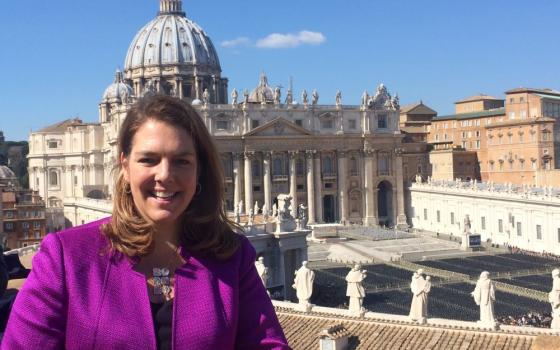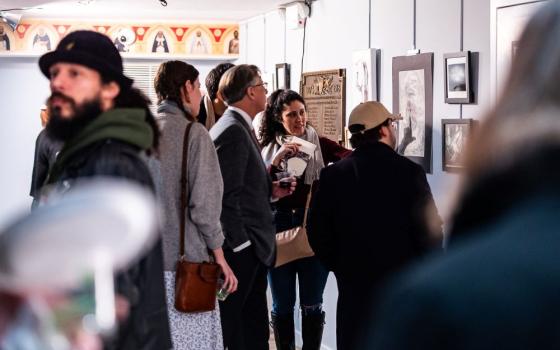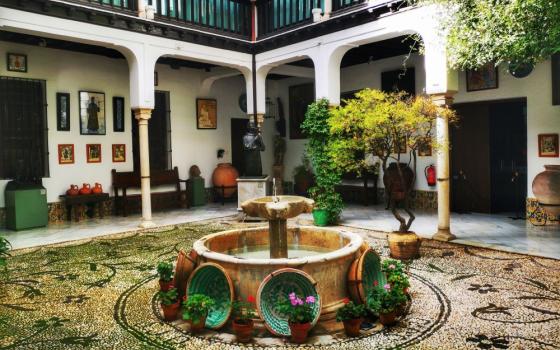I had to admit to myself, the cold wind felt good against my face yesterday as I joined members from three churches in midtown Kansas City as they assembled on a grassy parkway for our annual ecumenical observance of Palm Sunday. The palm branch I received might have come from El Salvador, where, just 24 hours earlier, I had boarded an early flight home after an 11-day visit to commemorate the 30th anniversary of the death of Oscar Romero, archbishop of San Salvador, murdered while saying Mass on March 24, 1980.
During my time there, temperatures hit 80 to 90 degrees every day, yet the air was so dry I hardly perspired and was warned to drink water frequently from a plastic bottle I carried everywhere to keep from getting dehydrated.
 Observing Palm Sunday back here in Kansas City now tied me to the same services there, one church spanning the hemispheres, north to south, and joined with all Christian churches around the world at this beginning of Holy Week.
Observing Palm Sunday back here in Kansas City now tied me to the same services there, one church spanning the hemispheres, north to south, and joined with all Christian churches around the world at this beginning of Holy Week.
Romero's dramatic death is inseparable from thousands of other, often anonymous and even more brutal, deaths in El Salvador, both before and then during the civil war he had tried so hard to prevent. To read Luke's account of the passion and death of Jesus is to read the script that unfolded in the agony that fell like night on El Salvador during that terrible time, a protracted nightmare of terror, disappearances, hostage-taking and torture that lasted nearly 20 years, scarring whole generations and leaving behind a wounded, divided country still in need to healing.
When the civil war erupted in 1980, a steady flow of advisors, Vietnam-era helicopters, weapons and ammunition to the military junta from the United States helped sustain an unpopular government for 12 long years of brutal counterinsurgency. The Carter, Reagan and Bush administrations, claiming they were preventing another communist-inspired revolution like the one that had toppled the Somoza dictatorship in neighboring Nicaragua in 1979, poured an estimated $5 billion into the conflict from 1980 to 1992. Fought to a stalemate, the war claimed over 75,000 lives, mostly innocent civilians caught between the army and leftist guerilla forces, forced a million people into exile and displaced another million internally, mostly rural poor, who fled to the mountains to escape the fighting, which included almost 200 large-scale civilian massacres.
More high-profile victims, like the four American church women who were raped and murdered in December of 1980 and the execution-style killing of six Jesuit priests and two coworkers on the campus of the University of Central America in San Salvador in1989, drew international attention and brought scores of religious and humanitarian activists into the country to monitor human rights abuses during the war and to pressure the U.S. Congress to cut funding to the Salvadoran military. As the war wound down, these same groups accompanied refugees from cross-border camps in Honduras and elsewhere trying to return to their homes. Out of this "accompaniment" grew many organizations that continue to provide solidarity with the Salvadoran people, to foster sister-church and sister-city networks that during the 1980s created the "Sanctuary" movement for refugees in the United States and Canada.
For my travel to El Salvador to cover the Romero anniversary for NCR, I joined a group of 55 North Americans led by the SHARE Foundation, an amazing organization that for the last 30 years has been part of the larger network of groups offering advocacy, legal support, development projects and delegation visits between churches in El Salvador and their partners in the United States.
Like many, though not all, of the people on the bus, I speak little Spanish, clung to my water bottle, packed poorly despite the detailed instructions, endured both an anxious entry into a country where hot showers and flush toilets are luxuries and experienced predictable gastrointestinal discomforts that await infrequent and inexperienced travelers. Over an eight-day period, our group went from being a carefully monitored huddle of school children on a field trip, taking pictures from the bus and pulling out hand sanitizers after every stop, to a fairly hardy community of fellow human beings who had been drawn slowly but surely into a life-changing embrace with one of the world's most hospitable places and people.
Holy Week begins with a procession. Jesus enters Jerusalem on the foal of an ass, a scriptural image for God's humble servant, but also in mock allusion to the triumphal entry of imperial conquerors of his day. And because history is itself a long procession inspired by the shared human desire for peace, security and development for ourselves and our children, for communities in which basic necessities are held to be a right and not a concession, we know this to be the common work of humanity. And because, as people of faith, we believe that history's procession is meant to arrive where the joy of life is celebrated family-style with the larger gift of creation, within a mystery whose purpose transcends the limits even of death, we also know that true religion must include human welfare in this world as well as salvation for the next. All of this is the lesson and the goal of Holy Week.
But getting there, liturgically and in history, has never been easy or assured without effort and never without suffering.
What I experienced in El Salvador and in the story of the martyred Monseñor Romero, I hope to share with you during the coming days Holy Week. I confess -- and every sojourner will recognize this vulnerability -- to being in the heightened post-partum stage of a personal passover that typifies visitors to El Salvador. It has challenged me to the core, has already had me in tears several times as I tried to tell friends about what I saw, the people I met, especially the children, or the insights that came crashing in on my carefully constructed worldview, shattering assumptions I have held for years about how the world works, or what God wants, or what the church must do to renew itself to echo God's voice in the world.
Despite the present turmoil in the church, I believe even more strongly that the institutional church must survive its current trials in order to position itself with others to help divert history from its present course, which has become a death trip for so many of our fellow human beings. If the institutional church does not step up with its deep, clear tradition on behalf of justice and human dignity, who will walk with those whose voices have been silenced and on whose backs fall the full weight of the heavy cross made of unjust structures, policies and priorities. These burdens cannot be sustained any longer; they are neither just nor tolerable for the vast majority of the human family, nor conscionable for those of us who have benefited from the suffering.
I hope by the end of this Holy Week, you will know why I believe that tiny El Salvador is so important and why it helps inform the drama we find in Holy Thursday, Good Friday and in the Easter message we all want to be the final act of our own stories, personal, national and global.
My thoughts will be open-ended to your comments and corrections, with a special invitation to send us links to your own Web sites, stories, photos and insights about your encounters with El Salvador. I learned one Spanish phrase that will serve me well: Ayuda me, por favor! Please help me tell this important story.
[Pat Marrin is editor of Celebration, NCR’s worship resource. He was in El Salvador covering the events surrounding the 30th anniversary of the assassination of Archbishop Oscar Romero, which was March 24.]
March 29: Holy Week 2010: Accompanying El Salvador, an introduction
March 30: Anointing
March 31: Darkness will have its hour
April 1, Holy Thursday: Fools rush in
April 2, Good Friday: Know when to fold 'em
April 3, Easter Vigil: Know when to hold 'em
| See also |




